How to structure your viva presentation (with examples)
Most PhD vivas and PhD defences start with a short presentation by the candidate. The structure of these presentations is very important! There are several factors and approaches to consider when developing your viva presentation structure.

Factors to consider when developing a viva presentation structure
Structuring your viva presentation traditionally, structuring your viva presentation around key findings, structuring your viva presentation around key arguments, structuring your viva presentation around case studies, final thoughts on viva presentation structures.
A PhD viva or PhD defence is often one of the last steps that PhD students have to pass before receiving a doctorate. The viva or defence usually starts with a short presentation of the PhD candidate on the PhD thesis.
Presenting a whole PhD in a short amount of time is very challenging. After all, a PhD is often the result of several years of work!
It is simply impossible to include everything in a viva presentation.
Therefore, tough choices have to be made in terms of what to include, what to highlight, and what to exclude.
The structure of a viva presentation plays a crucial role in bringing across the key messages of your PhD.
Therefore, there are several factors to consider when developing a viva presentation structure:
- Available presentation time : Viva presentations usually last between 10 and 20 minutes, but every university has different regulations. Developing a structure for a viva presentation that lasts 10 minutes is different from developing one for a presentation that lasts 20 minutes or more. Thus, find out how much time you are allowed to present!
- The key contribution of your thesis: The structure of a viva presentation should reflect the content and key messages of the PhD thesis. For instance, if you have written a very theoretical PhD thesis, it makes no sense to structure your whole presentation around your data collection and analysis. Make sure that the viva presentation structure is in line with your main messages.
- University standards: It is recommended to discuss your ideas and plans for your viva presentation structure with others, as each university may have may be different (and even unspoken) rules and standards. Ask your supervisors about their preferred viva presentation structure. And talk to your peers who defend their theses before you.
- Clear storyline : Every presentation should have a logical structure which allows the audience to follow a crystal-clear storyline. This is also true for viva presentations. Thus, clarify your storyline and develop a presentation structure that supports it.
A very traditional viva presentation structure simply follows the structure of the PhD thesis.
This means that the viva presentation covers all parts of the thesis, including an introduction, the literature review, the methodology, results, conclusions, etcetera.
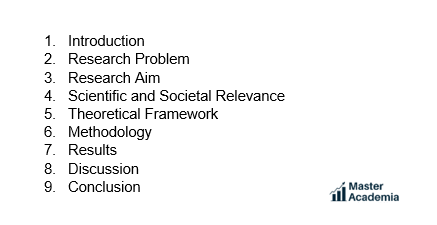
The advantage of this rather traditional format is that it provides information on each thesis chapter. Furthermore, it is relatively easy to prepare.
The disadvantage of this traditional format is that it is very challenging to fit all the information in a – let’s say – 10-minute presentation.
Furthermore, it can result in a presentation that is quite boring for the examiners, who have read the thesis in preparation for the viva.
One interesting way is to structure a viva presentation around the key findings of the PhD research.
For instance, you can select your three main findings which you each connect to the existing literature, your unique research approach and your (new) empirical insights.

A viva presentation structure around key findings emphasises the unique contribution of a PhD thesis, particularly in empirical terms.
A challenge of this structure, however, is to narrow down the presentation to a handful of key findings.
Furthermore, it might be tricky to find enough time during the presentation to discuss your theoretical framework and embed your discussion in the existing literature when addressing complex issues.
A viva presentation structured around key arguments is very similar to one that is structured around key findings. However, while key findings place more emphasis on the empirical data, key arguments operate at a higher level:
Arguments are sets of reasons supporting an idea, which – in academia – often integrate theoretical and empirical insights.
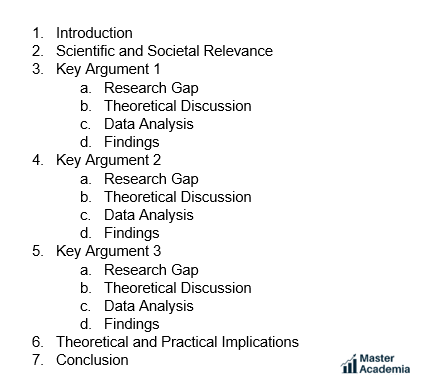
So, for example, your key argument 1 is your stance on an issue, combining your theoretical and empirical understanding of it. You use the existing theory to understand your empirical data, and your empirical data analysis to develop your theoretical understanding.
A viva presentation structure around key arguments is probably the most difficult viva presentation structure to choose.
However, if it is well done, it is probably the most academically strong and advanced way of defending your PhD.
Another common way to structure a viva presentation is around case studies or study contexts.
This structure is only applicable when the PhD thesis includes a comparative (case study) analysis, which is quite common in the social sciences and humanities.
A presentation can, for instance, first discuss the theoretical framework and research approach, then present Case 1, and then Case 2 or more if applicable.
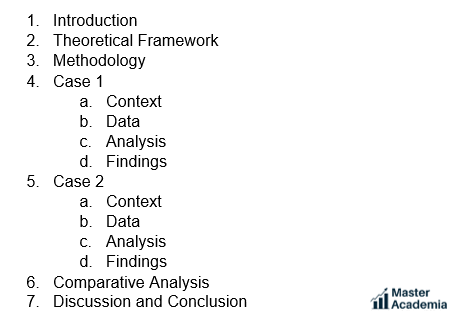
A viva presentation structure around case studies can be easy to follow for the audience, and shed light on the similarities and differences of cases.
However, as always, you need to reflect on whether the structure supports your key message. If your key message does not centre around similarities and/or differences in cases, this is not the structure for you!
Every PhD thesis is unique, and therefore also every viva presentation structure should be unique.
The key to a good viva presentation is to choose a structure which reflects the key points of your PhD thesis that you want to convey to the examiners.
The example viva presentation structures discussed here intend to showcase variety and possibilities and to provide inspiration.
Never just copy a viva presentation structure that worked for others .
Always think about what fits best to your thesis, asking yourself the following questions:
- What is the main message of my PhD that I want to share during my viva?
- How do I develop a crystal clear storyline to bring this main message across?
- How can I structure my viva presentation to support and facilitate this storyline?
Get new content delivered directly to your inbox!
Subscribe and receive Master Academia's quarterly newsletter.
18 common audience questions at academic conferences (+ how to react)
10 reasons to do a master's degree right after graduation, related articles.
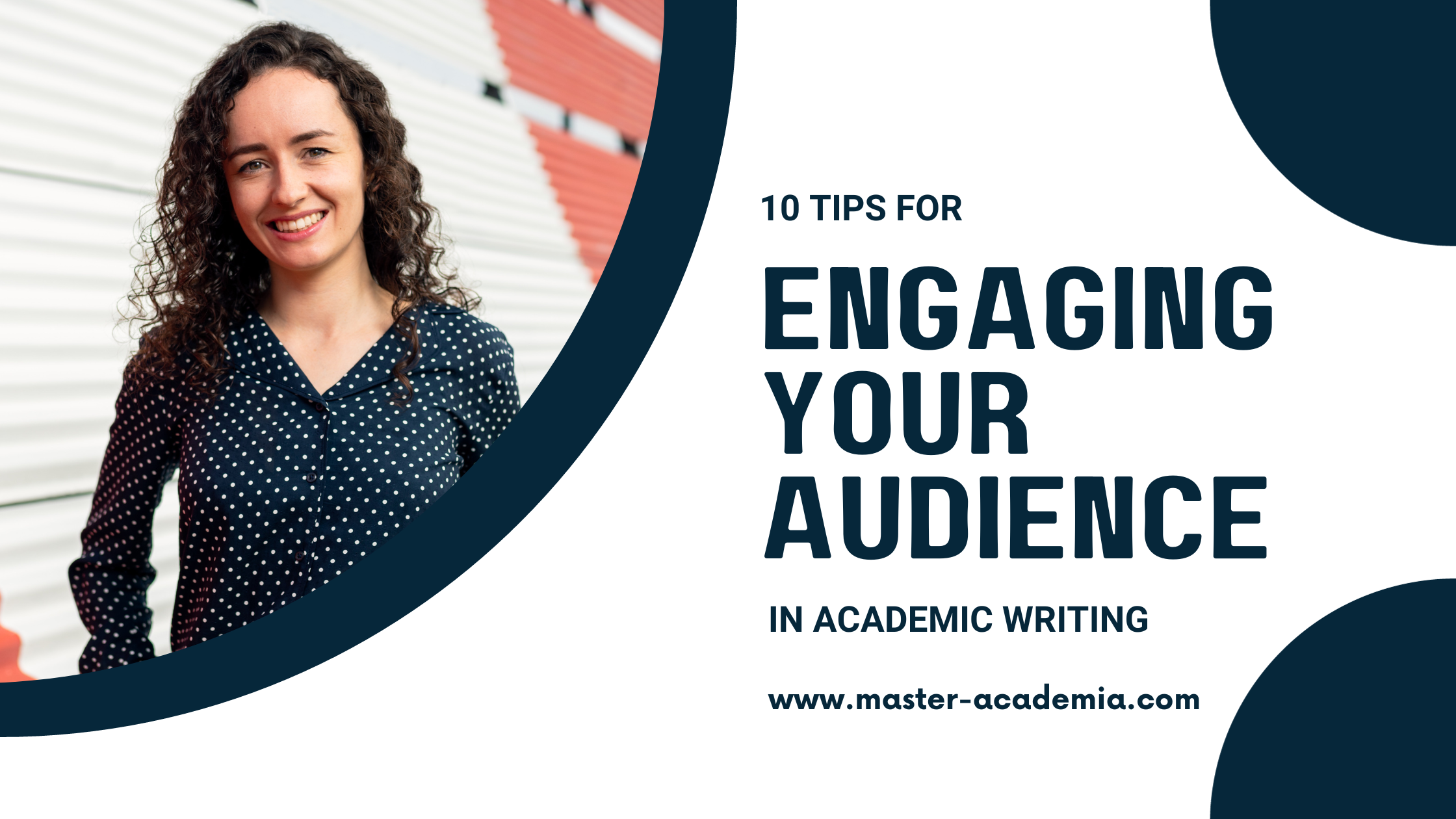
10 tips for engaging your audience in academic writing

How to disagree with reviewers (with examples!)

Introduce yourself in a PhD interview (4 simple steps + examples)

24 popular academic phrases to write your abstract (+ real examples)
Ace Your Viva Presentation: Tips and Tricks
The thought of an oral presentation can be a huge source of stress and anxiety for many students, while some just blossom in such situations. If you’re one of the former, though, don’t panic. With decent preparation and practice, you too can successfully master your viva presentation.
But first: what is a viva presentation?

Viva voce is a Latin phrase most often translated as “by word of mouth.” In academic circles, a viva presentation is an oral exam in which you defend your thesis.
After the thesis is defended, it’s discussed by a small panel. Among those present are the examining professors, but there may also be research assistants, members of the relevant department or even fellow students.
The purpose of this defense is to show examiners how knowledgeable you are on your research topic, that you have internalized what you have learned and know how to apply it. In effect, it shows that you are well prepared to enter into academic discussion.
In principle, the viva presentation won’t make an entire grade’s difference, but it can tip the proverbial scale in your favor. It does offer some major advantages: You can clear up any ambiguities, assuage any doubts your examiners may have, and show that your stand by your research.

Preparation is key
After months or even years of hard work, the thesis is finished, the last formatting mistakes corrected, the bibliography painstakingly checked one last time and hooray, it’s finished! Time to celebrate! And then you get an invitation to the viva …
So, the wine bottle is re-corked and it’s back to the desk. But the good news is: you’ve actually already done most of the preparation. That’s what all the in-depth research you did to create your thesis was. You’re already an expert on your topic, so now you just need to explain it to your examiners clearly and calmly. That’s why it doesn’t make sense to start preparing for your viva before your thesis is finished and you’ve answered all your own questions.
Your supervisor should already know what to expect and the purpose of the viva is to present your results. Some people just hand in their thesis with huge relief and then put the whole thing out of their mind for a while.
This isn’t necessarily a problem but when the viva presentation is due, you really need to give yourself time to familiarize yourself with the topic again. Re-read your thesis a few times to get your results and methods fresh in your mind and you’ve already done much of the prep work for your viva.

Organizational details
You need to check the examination regulations of your institution to find out what will be required of you during your viva presentation. How long should the presentation last? Who will be present? How will the discussion group be structured at the end? Studies have shown that anxiety is significantly lessened if you know exactly what to expect. Don’t ignore these details.
Make sure you have the right power supply for the projector and whether your slide format is compatible with the projector. An article on slide formats and the difference between 4:3 and 16:9 can be found here .
Know how long your presentation should be. This often depends on what type of work you’re presenting. Be sure to keep this in mind as you create your slides.
Also, think about whether or not you want to provide a handout. Even if it isn’t explicitly required, examiners will often use a handout as a guide when asking their questions, allowing you to better control the discussion that follows.
You can find helpful tips on handouts here .
Lastly, think about what you’re going to wear for your viva presentation. If you’re not sure, take a cue from your examiners. If they wear a suit or dress to other viva presentations, it’s safe to assume that the dress code for your viva will be on the formal side. It’s important to look neat and tidy, but you should also feel comfortable. The wrong shoes or clothing that is too tight can negatively impact the way you present. You can find more helpful tips on clothing here .

Technical details
The most popular tool for giving a viva presentation is PowerPoint. On the day of your presentation, get there early to make sure your devices are working. It also helps to be familiar with PowerPoint’s features, such as Presenter View. This fantastic tool will help you stay on track during your viva presentation. For more information on Presenter View, click here .
In general, the rule for viva presentations is: Keep It Simple . This is a defense of your academic research and your slides should express that. Keep it classic and factual. Use a uniform font and a neutral, preferably white, background. You can use backgrounds from PresentationLoad:

In principle, you should use as little text and as few key points as possible, but it’s also essential to document your research accurately. Room for interpretation can be very dangerous here.
Naturally, it depends on the preferences of the examiners, but a little more text than in normal presentations is definitely allowed. If the nature of your work allows, graphics, photos or flowcharts are a good way to offer some variety and to clearly present complex issues.
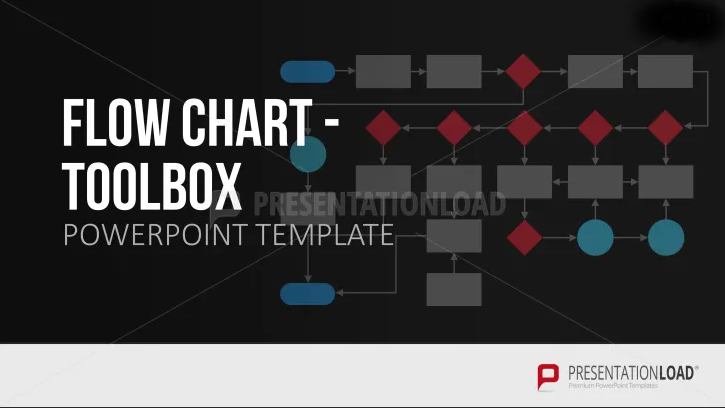
How to structure a successful viva presentation
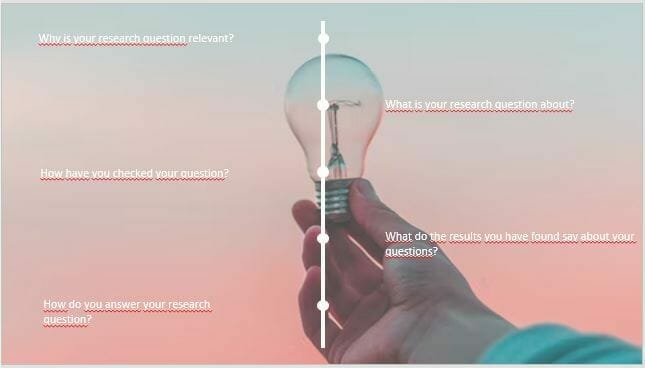
Like your thesis, your viva PowerPoint presentation should follow a certain structure. It is advisable to follow the structure of your thesis. After all, you have already given it a lot of thought and made sure that everything is in a logical context.
This way you can save yourself additional work. But remember – the presentation is not about retelling your thesis word for word. Just give the most important and interesting aspects.
Follow these points to create a solid structure for any viva presentation:
1) Relevance
Your thesis dealt in depth with a particular question, a specific aspect of research. In the first part of your viva PowerPoint presentation you introduce it and explain why it is relevant. What is the benefit for academic understanding, the general public, a specific avenue? Why this question in particular?
This allows you to show your audience why you chose your topic and why they should pay attention to what you have to say. All this needs to be supported by a professional introduction. You can find tips on how to do this here .
2) Background
This is where you set out the background of your research question in more detail, i.e. the most important theories and approaches that already exist on the topic, or which prompted your question. This helps your listeners prepare for any complex interrelationships, and clarifies the basis on which you have built your work.
In this part you set out how you approached your work. Was your research qualitative or quantitative? Did you conduct interviews, analyze data, evaluate a particular body of literature? This is your chance to show your examiners how carefully you worked and explain why you chose this particular method.
4) Findings
Now to present the results of your research. Were there any surprises? If so, how did you deal with them? Are the results consistent, where did you encounter difficulties, and how did you solve them? Use this section to talk about your research in a transparent and honest way. It’s an opportunity to show that you have dealt with the topic seriously and in depth, rather than just choosing the easiest way.
5) Conclusion
At the end, summarize your work clearly and concisely, and answer the research question posed at the beginning. You can also express your personal opinion as to whether you have achieved the result you expected or whether your research has come to a surprising conclusion.
Finally, you will need a well-rounded conclusion to your viva presentation. You can read tips for the perfect presentation ending here .
Whether you have to present your sources at the end of your viva is something to discuss with your supervisor or read up in the regulations. If in doubt, however, it’s better to be on the safe side with a list of sources.

Viva presentation: example
Since every viva is different, there is no one example of a great PowerPoint viva presentation. In our blog you will find numerous examples of how a well-structured and appealing PowerPoint presentation can look. For example, here . These should serve as a guide; it’s important to adapt the presentation to your personal requirements and your audience.
Make sure your narrative is clear and consistent throughout your presentation (as it was in your thesis). It might be a good idea to ask your supervisor to show you good viva presentation example from previous years or to give you tips on where you should focus your attention.

General tips for a successful presentation
Almost there! You’ve created and double-checked your PowerPoint viva presentation and you’re feeling confident about your research work. For many people, though, creating the content is the easy bit; it’s the thought of speaking in front of others that terrifies them. It’s just a fact that in order to defend a thesis, you first have to be attacked .
1. Be prepared for critical questions and comments. Think through what possible aspects of your work might attract criticism, and prepare your rebuttals in advance. It helps to let friends or family read your work and ask questions.
2. The same friends and family can be amazingly useful as a practice audience. Deliver your presentation a few times in front of others and in a relaxed environment. This will help you feel more confident when it comes time for your viva presentation. Your trial audience may discover inconsistencies you’d missed, and can often provide valuable feedback on how your slides look, your speaking style or your body language.
3. Body language is very important when you’re giving your presentation; it can affect your persuasiveness. Stand upright (or sit if you need to). A small amount of movement can emphasize your engagement with the subject, but try not to look restless. Getting your words across means you mustn’t turn your face away from the audience. Small gestures can underline your words, but too much fidgeting will look like nerves.
Practising giving your presentation will soon get your body language expressing ease and confidence. To learn how to best prepare for a presentation, read our blog article on the right body language
4. Many people tend to speak far too quickly in presentations, probably to get the whole thing over as quickly as possible. While this is understandable, it means the audience misses half your words! Try to breathe calmly and speak evenly.
Time can seem to speed up when you’re in a stressful situation, so speak more slowly than you think right. And taking a proper breath in between phrases will help ground you. You can find tips on how to prepare your speaking voice for your viva presentation in this blog post .
Your test audience can give you very good feedback here. When you practice your presentation, use a stopwatch to make sure that you stay within the given limits. Once you know that you won’t overrun even when speaking calmly, you can avoid the temptation to rush during the official presentation.
5. Pro tip: Do you have to give your viva presentation online? If so, some things will of course be different, starting with what program you use to stream your presentation. You can find out what options you have in this blog post . Click here to read more about what to pay attention to when giving an online presentation.

While knowing what you want to say is important, DON’T try to learn your entire presentation by heart. Even if you somehow did manage to, it would end up sounding artificial and you could be easily thrown off track if you miss a word or someone interrupts with a question. The best strategy is to memorize a few key points and speak freely.
Take a deep breath before you start and remember that you have no reason to be nervous. Nobody knows your work as well as you do; you’ve done all the research and can consider yourself an expert on your topic.
And if a mistake does happen, here are some tips on how to react to it with confidence.
If the examiners seem receptive to it, a little small talk before you start can help you to relax. And once you start, remember that you’ve practiced hard and are well prepared to give an impressive viva presentation. Good luck!
Any questions about this article or need help creating a viva presentation? Feel free to contact us at [email protected] for tips. We’d love to help.
We’ve already shared a lot of links with tips on how to improve your presentation . Here are some more that may interest you:
- PowerPoint animations
- PowerPoint Morph
- Humor in presentations
- Add images to your presentation with an app
- PowerPoint slide master
- The right presentation background
- How to create flowcharts
Share this post
- share
- save

Design Thinking: Problem Solving with a Difference

Why Corporate Mission Statements Are So Important

7 Tips & Learnings from the Apple Keynote
From admission to dissertation. Tips on making the PhD journey happy, productive and successful

18 tips to pass your Viva presentation
Viva Presentation of your PhD thesis requires you to prepare thoroughly. Viva Voce defense could be a failure if you don’t present properly. Learn tips on how to do PhD viva dissertation defense that makes you pass in doctoral viva. Face Viva exam confidently with an impressive opening speech. Keep some sample PhD viva questions and answers readily.
- Adjust voice as per the room size during the presentation of PhD viva.
- Clear Audibility is the first step for viva Voce success.
- Present Confidently viva thesis presentation.
- Do not stammer while defending PhD viva voce.
- Learn how to make an appropriate eye contact during PhD viva presentation.
- Keep ready some ready-made sample PhD viva answers.
- Know how to extend PhD viva validity.
- Never say you don’t know about any question
- Try to give your best from nothing during doctoral viva presentation.
Here are my detailed advanced tips on how to pass viva voce during your PhD studies. These viva tips will help you remain confident throughout your presentation
What is a Viva Voce?
A PhD scholar does not consider completing the thesis paper an accomplishment because they are still required to go through the viva voce process.
Although there are countries such as Australia that do not require one to do so, others like the United States necessitate the scholar to go through the process.
A viva voce is an oral examination whereby the researcher is required to stand before a panel of examiners to defend their dissertation .
This is why it is essential for the scholar to ensure that they have clearly mastered the field and the chosen topic by conducting the research on their own.
During the viva voce, the evaluators are at liberty to ask whatever question they feel is related to the topic and the candidate has the obligation of answering the question satisfactorily.
Simply put, a viva voce is an oral presentation that is aimed at proving that the researcher commands knowledge on the topic and has gained knowledge on the field of study.
When is PhD Viva voce examination conducted during PhD
A PhD viva voce examination is the last thing that comes in the PhD process whereby the researcher is required to present themselves before evaluators and answer any questions thrown at them regarding the thesis.
That said, the viva voce comes after the candidate has submitted their thesis to the faculty. Upon receiving the research paper, the evaluators may require the scholar to present themselves in person and required to exhibit what they have learned during the Ph.D. process.
Therefore, a viva voce comes after submission of the thesis and before the candidate earns the doctorate title.
How long is the PhD Viva Voce Presentation with example
Many Ph.D. candidates are concerned by the duration that a viva voce takes and we would like to point out that it all depends on how prepared one is for the same.
Traditionally, a viva voce is supposed to take ninety minutes with no hassles. However, it boils down to the examiners’ decision and if they feel that the time is not enough, then they can extend the process up to three hours.
The purpose of the process is to evaluate how much knowledge one has acquired during the Ph.D. and whether they are capable of answering questions related to their topic.
Therefore, it is true to state that the length of the viva voce will depend on the examiners. If the candidate does not satisfy their expectations, they are bound to ask more questions thus the process I likely to take more time
How many examiners will site in PhD Viva Examination
Many scholars are concerned about with the viva voce since it makes almost all candidates nervous as is the case of any situation where one has to stand before viva examiners and defend their work.
When one is deemed qualified to do a Ph.D., they are assigned a supervisor who ensures that the Ph.D. process is not marred by challenges through offering advice to the scholar.
The examiners are mostly two all of which should come from the university’s faculty. To ensure that the evaluation process is effective, they are mostly chosen from the same field as the candidate. Although it is not a must, there are occasions where the examining body may also comprise of external members.
This implies that the minimum number of examiners is two but they can be more according to the university’s decision.
Viva Preparation Questions
- What is the new thing that one feels to read your PhD dissertation?
- How do you prove this experiment can change the way others think?
- Explain the validity of your proposition with some examples.
- Give one strong why should we accept your thesis to be authoritative.
- What influenced you to make your thesis stand out from others
Why is PhD Viva Presentation conducted
A thesis is nothing short of a research paper which means that the scholar is expected to have taken their time to conduct thorough research using advanced techniques.
The main reason why a viva voce is conducted is to give the researcher an opportunity to defend their work before they are graded whether they meet qualifications or not.
The first thing that the scholar should know is that they should be able to defend their thesis which means that they should be aware of everything that is in the research paper. The reason for this is because one can never know what the examiners will ask and from which section of the thesis they will derive their questions.
It is essential that the scholar must ensure that they are prepared adequately by going through their thesis and ensure that they are able to answer any question arising from the same.
There are candidates who may be tempted to have other people write their thesis and although it may be perfect, the viva voce reveals the truth depending on whether they can defend the thesis or not.
Be what you are in your PhD Viva Exam
According to many candidates, the viva voce is an impeachment whereby they feel like they are grilled, but in a real sense, it is designed to prove to themselves and others whether they are in a situation to defend their title as a doctor of philosophy in their field.
It is therefore important for the candidate to ensure that they do not fall prey to brown nosing. They should not direct their efforts to sweet-talk the examiners by trying to impress them. Instead, the scholar is advised to play their role and prove to the evaluators that they are capable of defending what they have written in the thesis.
It is recommended that the scholar should be calm, relaxed and confident in their thesis and have the courage to stand before the examiners and express themselves.
The candidate should recognize the importance of the thesis and this is partly the reason why they have the responsibility of choosing their own topic and doing the research.
Never give one-word answers during Viva Voce viva exam
A viva voce must not be confused with a multiple choice questionnaire thus the researcher must appreciate that it is intended to diminish curiosity.
This cannot be achieved by giving one-word answers because the scholar is required to explain themselves as reflected in the thesis. Important to note is that a person’s standing or view on a certain view cannot be explained in a short statement.
The reason for this is because when one is asked a question during the viva voce, they are expected to state their position on the matter. The statement is not enough because it only triggers more questions.
Therefore, it is necessary that the scholar must support their claim by giving explanations as to why they support their arguments. In fact, the primary purpose of the viva voce is to ensure that the scholar can defend what they advocate for thus they should be in a position to give explanations and proof of what they are saying.
Be confident throughout the session (not over confident) during doctoral viva
According to human nature, there are people that find it easy to stand before others and air their view but the viva voce does not recognize that. It is essential that the scholar must be in a position to present themselves and stand for what they have presented to the faculty and the world.
At this level of learning, it is expected that the scholar must be confident enough to ensure that they can speak in front of a crowd leave alone two or three examiners. Confidence is a virtue that must be acquired by all scholars to ensure that they can stand before others and teach them or address key concerns that affect society.
However, the candidate must take caution not to be overconfident and the main reason for this is that too much confidence is interpreted as arrogance.
The bad thing about this is that the examiners are likely to get the wrong impression about the scholar. This is true because among the virtues that a Ph.D. teaches the candidate is patience and respect for others.
Do not show that you are afraid of Viva Voce of dissertation
The human mind is designed in such a manner that it controls the entire body and command activities that the individual will like and those that they will not.
One of the reasons why most scholars fail the viva voce process is that they tend to develop a negative attitude towards the same even before they go through the process.
It is essential that the scholar must be confident and not only outwardly but also inwardly. We recommend the scholar to ensure that they take all necessary measures to ensure that they do not exhibit fear in front of the examiners.
It is understandable that anyone is capable of nervousness while in front of a panel of examiners. However, we recommend that the scholar must pay attention to two things to boost their confidence. The first element is that they should prepare adequately for the process.
The second is that they should develop a positive attitude towards the viva voce. Adhering to these two advises is bound to increase the scholar’s confidence in themselves and their thesis.
My top Viva advice is to practice before one month
In the scholar’s life, before they take the Ph.D. course, it is true to say that they have gone through many examinations and passed. It is not automatic to pass an examination and it requires a lot of dedication and sacrifice.
Although there are individuals that may be tempted to take a shortcut, there is only one recipe to passing. All examinations require a lot of preparation and a viva voce is not exceptional.
This implies that the scholar must take their time to prepare for the viva voce beforehand. It is recommended that the candidate should take at least one month to prepare themselves.
It may seem like a difficult thing to do but we remind the scholar that they have a supervisor who has knowledge about the viva voce and they can offer useful advice that can make the process easy for the candidate.
Dress proper and be neat and formal during thesis viva preparation
The short description of a viva voce is that it is an oral presentation and therefore it means that there must be physical appearance.
Appearance has a powerful effect in that it creates a lasting impression on the examiners and therefore, the way that one presents themselves before the evaluators automatically make them judge the candidate’s character. The scholar wants the evaluators to be on their side and therefore the first thing that should pop in the scholar’s mind is creating a good impression.
It is essential because it may affect the examiners’ judgment which implies that a good impression is likely to yield good results while a bad impression is likely to yield bad results.
It is crucial that the scholar must dress formally for the viva voce and they should be neat. The proper dressing makes the scholar look responsible and in a position to defend their thesis.
Read your thesis once and thrice and prepare sample PhD viva answers
The viva voce is an oral presentation of the thesis and therefore it is necessary that the scholar must ensure that they have a proper understanding of their thesis before they engage with the examiners.
It is purposeful for the scholar to have 100% knowledge of the thesis even though it is common to forget some points. To avoid mistakes arising from being unable to answer some examiners’ questions, we recommend the scholar to make a point of revising the thesis before and after submitting to the faculty.
Some scholars might consider reading the thesis twice sufficient but this is not the case.
Others may be overconfident and feel that they do not have to read the thesis again but this is usually a recipe to disaster. It is our recommendation that the scholar reads through the thesis at least three times to ensure that they are familiar with all the points discussed within.
Learn how to start your opening speech of PhD Viva
It may sound tricky to summarize a paper comprising of at least 50,000 words in as little as five minutes but it is possible and the scholar should practice doing so.
Essentially, the examiners expect the scholar to have mastered their thesis and therefore they should be able to point out the problem surrounding the topic as well as the causes and recommended solution briefly.
At the onset of the viva voce, the scholar must be in a position to introduce the dissertation to the examiners briefly. This involves presenting an overview of the research paper.
Among the different sections of the thesis is the abstract section which was explained as a summary of the research paper. While preparing for the viva voce, the candidate is advised to consider the abstract and use it as a guideline for the oral presentation.
Listen to what your examiner is asking clearly
The easiest way to fail in any examination is answering the wrong questions or failing to address what the examiner requires.
It is mandatory for the candidate to pay attention to what the examiner is asking and carefully analyze points that they require from the candidate.
By doing so, the scholar is in a position to give the right feedback with reference to the thesis. It means that it is important for the candidate to concentrate during the viva voce and they should ensure that they are not distracted by anything else. 100% concentration is a requirement for the viva voce process if the candidate is going to answer questions satisfactorily.
Do not argue under any circumstance (just defend)
It should be noted that a viva voce is not a form of a debate where two parties are engaged in arguing. The candidate should note that the examiners are already professors and they are not there to engage in a battle of wits.
What they require from the candidate is proof that they have learned during the research and that they are in a position to demonstrate that they command knowledge in their specific fields.
That said, rather than argue, the candidate must ensure that the presentation is based on defending the thesis and shows the validity of the scholar’s standing regarding the points presented in the dissertation.
Pass- short corrections-resubmit- Fail after Ph.D. Viva defense
After the oral presentation, the examiners make a point of presenting their results to the candidate which point out areas that were sufficiently answered and those that were not.
The candidate should look into areas where they gave wrong answers and make a point of researching and making the necessary changes.
The correct answers should be passed to the examiners. The candidate must ensure that the correct answers are written as briefly as possible.
Do not write stuff on your hands or hold slip while defending viva thesis
During the oral presentation, it is necessary that the scholar avoids writing points in their hands or slip. It is so because it acts as a way of showing that the scholar has not prepared sufficiently for the viva voce.
In addition, it creates the impression that the researcher is not fully aware of the content in the thesis. Using written points give the impression of someone who is presenting a speech that has been written for them.
The candidate does not want the examiners feeling that they have not done the research for themselves as this would automatically lead to a fail.
How to do viva presentation with an impressive eye contact
A good presentation is one that the candidate commands presence before the examiners as it shows that they are confident with their work. It also shows that the scholar has worked hard for the thesis and they have nothing to fear regarding the viva voce.
One way of showing the examiners that the candidate is prepared and has dedicated themselves to the research is by making constant eye contact with the examiners.
The researcher should also be careful not to give too much attention to one examiner and instead they should keep eye contact with all the researchers during the whole viva voce.
Plan some expected questions and your answers
Whichever situation that one finds that they are required to make a presentation before a panel or a group of people, the first thing that the person does is to prepare adequately.
It is useful for the candidate to expect some questions that are likely to be asked during the presentation and therefore the scholar should make a list of some of them and work on possible answers.
Although one cannot fully predict the type of questions, it is important for the candidate to conduct a research of previous viva voce that have been done on the same field. Also, the scholar must consult the supervisor who may have useful advice.
Be ready to explain the drawbacks of your thesis cleverly
There is no perfect research and all of them are liable to limitations which the candidate must make a point of acknowledging before they are asked.
The scholar must be prepared to mention the drawbacks and explain why they arise. Merely stating the drawbacks is not enough since it will only make the examiners curios and therefore the candidate must defend the thesis wit-fully taking care to show that the limitations could not be avoided.
Challenges encountered during the thesis should be noted since they might be helpful in explaining the limitations or drawbacks.
Make rehearsals before two days of your viva voce
It has been noted that the scholar must ensure that they are fully prepared for the viva voce before meeting the examiners. Apart from reading through the thesis at least three times, the candidate should ensure that they prepare for the presentation prior to the scheduled day of the meeting.
If possible, the candidate is advised to look for friends and prepare a mock viva voce whereby they act as the examiners and ask questions that the candidate feel could potentially be asked.
This process should be done at least two days before the presentation. A rehearsal is important because it assists the candidate to engage how much they know pertaining to their thesis and some areas that may not have been given adequate attention can be addressed.
Never say “I don’t know” Somehow defend PhD viva (Be it wrong its ok)
A research paper consists of a lot of content and it may not be possible to remember everything that is contained in the same. It is common for the examiners to ask questions that the candidate has not prepared themselves to answer but this should not deter them from answering.
In case the candidate encounters such questions, they should not hastily state that they do not have the answer. Instead, the candidate should take their time and reflect on the thesis and analyze the connection between the question and the thesis.
It is understandable if the answer is not correct but at least the candidate should try to answer the question.
Prepare some positive statements of English to use them during presentation of your viva
One way of preparing for the viva voce is to ensure that one has answers to the examiner’s questions. The main areas of concern are the main points and how they are relevant to the topic.
A presentation must have statements that can be defended at all times since they help the scholar to show the importance of the thesis to the community. Such statements must be positive in nature and exhibit backing up of the thesis.
They should be prepared in English since it is the universal language that is applicable to almost all job specifications in the job market.
How to present PhD viva presentation positively
Positive statements are one way of the researcher showing that they have confidence in themselves and the thesis. Throughout the viva voce, the candidate must ensure that they have a positive attitude which is essential because it draws the examiners on their side.
A positive attitude makes it possible to answer questions easily and there is a likelihood that the examiners may not ask questions that put the candidate in bad situations. It enables the scholar to be motivated and therefore they are able to answer questions freely without feeling tense.
Be audible and do not look shy during thesis viva presentation
It is understandable that some people may have difficulty in standing before people and speaking their minds. However, the scholar is advised to remember that this is their dissertation and the presentation is among the stakeholders that determine whether one will pass or fail.
To counter shyness, the candidate is advised to prepare themselves adequately before the viva voce process. It is important because it boosts the candidate’s moral and level of motivation.
A scholar that is prepared becomes confident in themselves and they also develop a positive attitude which makes it easier to face the examiners and answer any question hurled at them without fear.
If you have had any experience with public speaking skills, you can do this task very easily. But unfortunately, you might have been lazy not to learn these skills when your English Teacher taught you during your school days. You need to give your count now while doing your Ph.D. viva. These skills are very necessary to get through these oral sessions. The way you speak is what matters seriously for the examiners or the reviewers.
Once you are through enough to make it, you can become successful. This way you can become a lot more confident and you will pass this viva without any doubt. While presenting do remember that you have to make some preparation for the last two months. This preparation is the only backbone for your viva. If you do not prepare beforehand you will face trouble while presenting your Ph.D. viva oral
When you keep this in mind, there are some other tips, I want to give here. See how PhD candidates do their viva online. If you go on to youtube you will get many videos in real time. Learn from them how they are able to present during such stressful sessions. I suggest you watch at least one video about Ph.D. viva or any other sessions with respect to Viva. This will surely give you fuller knowledge and viva presentations presentation tips about viva
When you want to give Ph.D. viva, try to show respect who are around you. They may be irritating sometimes to face. But you must never lose temper if someone asks you an inappropriate question. These type of unrelated questions are very common while giving your Ph.D. viva oral examination.
Master all the techniques on how to face audience and PhD supervisor during your viva voce. The way you speak, the way you behave, the way you respond, the way you manage, the way you present. All such skills must be learned before going to viva session.
You cannot make yourself a bluff in front of others for simple questions. So in order to avoid this, you must take your viva seriously and make sufficient preparation.
Never lose heart rather increase your active participation in the viva. If someone corrects you, accept it humbly and proceed to the next defending minutes. So Ph.D. viva is not a big problem if you follow all these suggestions throughout the reading on how to do Ph.D. Viva Voce.phd viva tips
Syam Prasad Reddy T
Hello, My name is Syam, Asst. Professor of English and Mentor for Ph.D. students worldwide. I have worked years to give you these amazing tips to complete your Ph.D. successfully. Having put a lot of efforts means to make your Ph.D. journey easier. Thank you for visiting my Ph.D. blog.

You May Also Like


Google Jam topics

Top 100 Jam topics in an Interview Session

How to Introduce Myself in Jam Session
- Interesting
- Scholarships
- UGC-CARE Journals
Tips to Prepare PhD viva-voce Presentation Slides
Best Ph.D. viva ppt slide preparation tips

Table of contents
Sample ph.d. viva-voce presentation slides, tips to prepare ph.d. viva-voce presentation slides.
Preparation of neat PhD viva -voce presentation slides and presenting them in a perfect manner in the given time is very important for a PhD viva-voce examination as it going to give a good impression on both research scholar and supervisor or mentor by the examiners or moderators.
Before designing the presentation slides, the scholar has to decide what to include and what not to include in the slides. It is always a big deal for a scholar to include all the research findings, data in the presentation that was obtained during the research program (4 to 5 years).
The scholar has to remember that the presentation should include only the major research findings and key contributions as time management is important. Therefore, in this article, iLovePhD framed simple and useful tips to prepare Ph.D. viva-voce presentation slides.
The format of the presentation slides is presented below. This would give you an idea to prepare the slides.
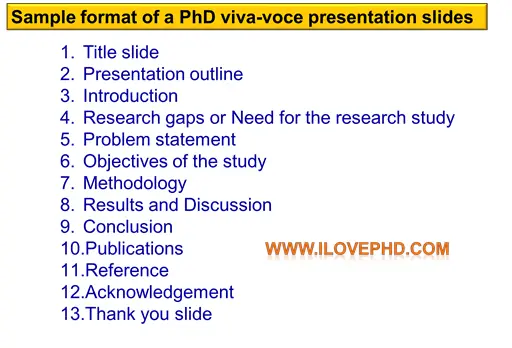
- Give brief introduction about the background of your study. Always present the points in a bulleted manner (4 to 5 points) rather than paragraph.
- Highlight the research gaps or the need for the research study and present your problem statement clearly.
- List the objectives and methodology of your study with neat schematics.
- Present the important research findings and data presented in your thesis in a simple and bulleted manner. Don’t explain it as a paragraph in the slide rather you can give the detailed explanation with scientific evidences during your defence presentation.
- Connect your findings with past relevant literatures and emphasis the novelty of your research.
- Use schematics, graphs, and tables with experimental conditions rather than detailed statements.
- Summarize the results of your research objectives and conclude the research outcomes with societal benefits.
- Use hyperlinks at appropriate places for presenting huge and important data (Datasets, experimental procedures, literatures).
- Ensure the quality of the images as it should be clear and readable.
- Limit your presentation slides to 50 to 55 slides.
- Check the flow and connectivity between each slide.
We hope this article would be very much useful for the Ph.D. research scholars who are preparing their defense presentation slides irrespective of their area of research. We wish you all the best!!!
Also Read: Top 38 Possible PhD Viva Questions
- best phd viva presentation ppt
- phd viva presentation
- phd viva presentation tips
- presentation
- presentation tips
- Research Tips
- Thesis presentation tips
- viva-voce ppt
What is a Research Design? Importance and Types
How to download free ieee dataset – 2024, top scopus indexed journals in management 2024, leave a reply cancel reply.
Notify me of follow-up comments by email.
Notify me of new posts by email.
Email Subscription

iLovePhD is a research education website to know updated research-related information. It helps researchers to find top journals for publishing research articles and get an easy manual for research tools. The main aim of this website is to help Ph.D. scholars who are working in various domains to get more valuable ideas to carry out their research. Learn the current groundbreaking research activities around the world, love the process of getting a Ph.D.
WhatsApp Channel
Join iLovePhD WhatsApp Channel Now!
Contact us: [email protected]
Copyright © 2019-2024 - iLovePhD
- Artificial intelligence

- PhD Viva Voces – A Complete Guide
- Doing a PhD
- A PhD viva involves defending your thesis in an oral examination with at least two examiners.
- The aim of a PhD viva is to confirm that the work is your own , that you have a deep understanding of your project and, overall, that you are a competent researcher .
- There are no standard durations, but they usually range from one to three hours, with most lasting approximately two hours .
- There are six outcomes of a PhD viva: (1) pass without corrections (2) pass subject to minor corrections, (3) pass subject to major corrections, (4) downgrade to MPhil with no amendments, (5) downgrade to MPhil subject to amendments, (6) immediate fail.
- Almost all students who sit their viva pass it, with the most common outcome being ‘(2) – pass subject to minor corrections’.
What Is a PhD Viva?
A viva voce , more commonly referred to as ‘viva’, is an oral examination conducted at the end of your PhD and is essentially the final hurdle on the path to a doctorate. It is the period in which a student’s knowledge and work are evaluated by independent examiners.
In order to assess the student and their work around their research question, a viva sets out to determine:
- you understand the ideas and theories that you have put forward,
- you can answer questions about elements of your work that the examiners have questions about,
- you understand the broader research in your field and how your work contributes to this,
- you are aware of the limitations of your work and understand how it can be developed further,
- your work makes an original contribution, is your own and has not been plagiarised.
Note: A viva is a compulsory procedure for all PhD students, with the only exception being when a PhD is obtained through publication as opposed to the conventional route of study.
Who Will Attend a Viva?
In the UK, at least two examiners must take part in all vivas. Although you could have more than two examiners, most will not in an attempt to facilitate a smoother questioning process.
One of the two examiners will be internal, i.e. from your university, and the other will be external, i.e. from another university. Regardless, both will be knowledgeable in your research field and have read your thesis beforehand.
In addition to your two examiners, two other people may be present. The first is a chairperson. This is an individual who will be responsible for monitoring the interview and for ensuring proper conduct is followed at all times. The need for an external chairperson will vary between universities, as one of the examiners can also take on this role. The second is your supervisor, whose attendance is decided upon by you in agreement with your examiners. If your supervisor attends, they are prohibited from asking questions or from influencing the outcome of the viva.
To avoid any misunderstandings, we have summarised the above in a table:
Note: In some countries, such as in the United States, a viva is known as a ‘PhD defense’ and is performed publicly in front of a panel or board of examiners and an open audience. In these situations, the student presents their work in the form of a lecture and then faces questions from the examiners and audience which almost acts as a critical appraisal.
How Long Does a Viva Last?
Since all universities have different guidelines , and since all PhDs are unique, there are no standard durations. Typically, however, the duration ranges from one to three hours, with most lasting approximately two hours.
Your examiners will also influence the duration of your viva as some will favour a lengthy discussion, while others may not. Usually, your university will consult your examiners in advance and notify you of the likely duration closer to the day of your viva.
What Happens During a Viva?
Regardless of the subject area, all PhD vivas follow the same examination process format as below.
Introductions
You will introduce yourselves to each other, with the internal examiner normally introducing the external examiner. If an external chairperson is present, they too are introduced; otherwise, this role will be assumed by one of the examiners.
Procedure Explained
After the introductions, the appointed chair will explain the viva process. Although it should already be known to everyone, it will be repeated to ensure the viva remains on track during the forthcoming discussion.
Warm-Up Questions
The examiners will then begin the questioning process. This usually starts with a few simple opening questions, such as asking you to summarise your PhD thesis and what motivated you to carry out the research project.
In-Depth Questions
The viva questions will then naturally increase in difficulty as the examiners go further into the details of your thesis. These may include questions such as “What was the most critical decision you made when determining your research methodology ?”, “Do your findings agree with the current published work?” and “How do your findings impact existing theories or literature? ”. In addition to asking open-ended questions, they will also ask specific questions about the methodology, results and analysis on which your thesis is based.
Closing the Viva
Once the examiners are satisfied that they have thoroughly evaluated your knowledge and thesis, they will invite you to ask any questions you may have, and then bring the oral examination to a close.
What Happens After the Viva?
Once your viva has officially ended, your examiners will ask you to leave the room so that they can discuss your performance. Once a mutual agreement has been reached, which can take anywhere from 10 minutes to an hour, you will be invited back inside and informed of your outcome.
PhD Viva Outcomes
There are six possible outcomes to a viva:
- Immediate award of degree: A rare recommendation – congratulations, you are one of the few people who completely satisfied your examiners the first time around. You do not have to do anything further at this point.
- Minor amendments required: The most common recommendation – you obtain a pass on the condition that you make a number of minor amendments to your thesis, such as clarifying certain points and correcting grammatical errors. The time you have to make these changes depends on the number of them, but is usually one to six months.
- Major amendments required: A somewhat uncommon recommendation – you are requested to make major amendments to your thesis, ranging from further research to collecting more data or rewriting entire sections. Again, the time you have to complete this will depend on the number of changes required, but will usually be six months to one year. You will be awarded your degree once your amended thesis has been reviewed and accepted.
- Immediate award of MPhil: An uncommon recommendation – your examiners believe your thesis does not meet the standard for a doctoral degree but meets the standard for an MPhil (Master of Philosophy), a lower Master’s degree.
- Amendments required for MPhil: A rare recommendation – your examiners believe your thesis does not meet the standard for a doctoral degree, but with several amendments will meet the standard for an MPhil.
- Immediate fail: A very rare recommendation – you are given an immediate fail without the ability to resubmit and without entitlement to an MPhil.
Finding a PhD has never been this easy – search for a PhD by keyword, location or academic area of interest.
What Is the Pass Rate for Vivas?
Based on an analysis of 26,076 PhD students who took their viva exam between 2006 and 2017, the PhD viva pass rate in the UK is 96%; of those who passed, about 80% were required to make minor amendments to their thesis. The reason for this high pass rate is that supervisors will only put their students forward for a viva once they confidently believe they are ready for it. As a result, most candidates who sit a viva are already well-versed in their PhD topic before they even start preparing for the exam.
How Do I Arrange a Viva?
Your viva will be arranged either by the examiners or by the chairperson. The viva will be arranged at least one to two months after you have submitted your thesis and will arrange a viva date and venue that is suitable for all participants.
Can I Choose My Examiners?
At most universities, you and your supervisor will choose the internal and external examiners yourselves. This is because the examiners must have extensive knowledge of the thesis topic in order to be able to examine you and, as the author of the thesis in question, who else could better determine who they might be than you and your supervisor. The internal examiner is usually quite easy to find given they will be from your institution, but the external examiner may end up being your second or third preference depending on availability.
Can I Take Notes Into a Viva?
A viva is about testing your competence, not your memory. As such, you are allowed to take notes and other supporting material in with you. However, keep in mind that your examiners will not be overly impressed if you constantly have to refer to your notes to answer each question. Because of this, many students prefer to take an annotated copy of their thesis, with important points already highlighted and key chapters marked with post-it notes.
In addition to an annotated copy of a thesis, some students also take:
- a list of questions they would like to ask the examiners,
- notes that were created during their preparation,
- a list of minor corrections they have already identified from their viva prep work.
How Do I Prepare for a PhD Viva?
There are several ways to prepare for a PhD viva, one of the most effective being a mock viva voce examination . This allows you to familiarise yourself with the type of viva questions you will be asked and identify any weak areas you need to improve. They also give you the opportunity to practise without the pressure, giving you more time to think about your answers which will help to make sure that you know your thesis inside out. However, a mock viva exam is just one of many methods available to you – some of the other viva preparation methods can be found on our “ How to Prepare for a PhD Viva ” page.
Browse PhDs Now
Join thousands of students.
Join thousands of other students and stay up to date with the latest PhD programmes, funding opportunities and advice.

How to Ace Your PhD Viva Voce
It is your Ph.D. viva voce! Years of your research work has to be presented in a short duration. Are you in a dilemma, how to go about it? It is a nerve-racking experience to present your research work leading to the award of the doctoral degree. Giving a perfect presentation is essential. Every step needs to be meticulously done from preparing your powerpoint presentation to the delivery of your work. We offer you straightforward and practical tips to overcome fear and deliver an excellent presentation in the infographic given below
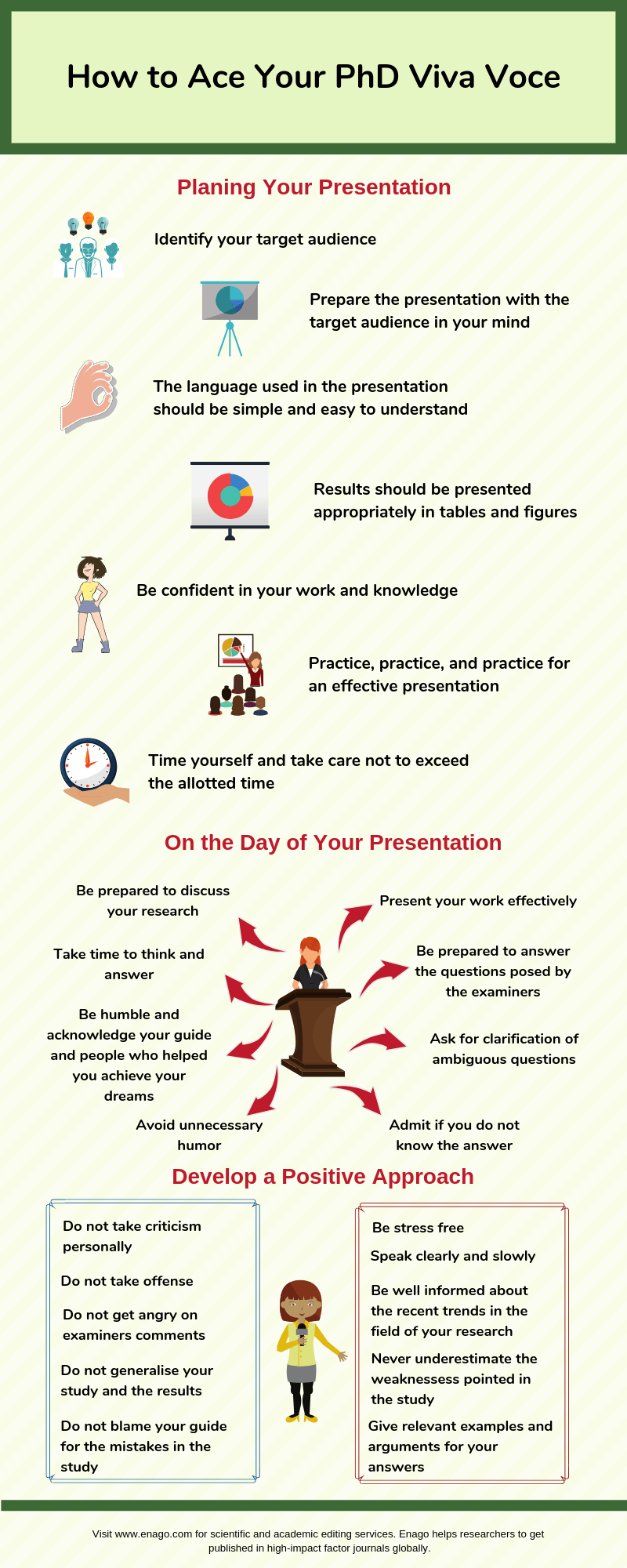
Rate this article Cancel Reply
Your email address will not be published.

Enago Academy's Most Popular Articles

- Reporting Research
Choosing the Right Analytical Approach: Thematic analysis vs. content analysis for data interpretation
In research, choosing the right approach to understand data is crucial for deriving meaningful insights.…

Comparing Cross Sectional and Longitudinal Studies: 5 steps for choosing the right approach
The process of choosing the right research design can put ourselves at the crossroads of…

- Career Corner
Unlocking the Power of Networking in Academic Conferences
Embarking on your first academic conference experience? Fear not, we got you covered! Academic conferences…

Research Recommendations – Guiding policy-makers for evidence-based decision making
Research recommendations play a crucial role in guiding scholars and researchers toward fruitful avenues of…

- AI in Academia
Disclosing the Use of Generative AI: Best practices for authors in manuscript preparation
The rapid proliferation of generative and other AI-based tools in research writing has ignited an…
International Conference Presentation Guide: The ultimate do’s and don’ts
Digital Learning and Its Benefits to Researchers
5 Important Tips When Moving to an Industry Career
Importance of Editing and Proofreading in Academic Writing

Sign-up to read more
Subscribe for free to get unrestricted access to all our resources on research writing and academic publishing including:
- 2000+ blog articles
- 50+ Webinars
- 10+ Expert podcasts
- 50+ Infographics
- 10+ Checklists
- Research Guides
We hate spam too. We promise to protect your privacy and never spam you.
I am looking for Editing/ Proofreading services for my manuscript Tentative date of next journal submission:

What should universities' stance be on AI tools in research and academic writing?
PhD Assistance
How do i prepare for a phd viva, phd viva presentation, phd viva questions.
It is a matter and pride great amount of pride to get done with your Ph.D. degree. A great number of efforts goes into making it happen. But preparing dissertations, thesis and getting it reviewed by the panel is no less than a herculean task. Even though you are done with preparing your thesis, yet the journey continues. There exists one big task to complete or to say a bridge to cross before finally getting your thesis approved and being conferred with the doctorate. This essential part during the doctorate or Ph.D. program is the viva. After you have prepared your thesis, the next step is submission to the panel wherein it will be reviewed and the student will be intellectually tested for their knowledge that they have put into the process.
Passing through this hurdle will ensure your doctorate degree which requires little more labor and a lot of sharp wits. So, before heading on to discuss how one can manage or survive the rig-ours of Ph.D. viva let’s take a sneak peek through the actualities of why the viva is conducted and later move towards tips and tricks to ease the entire process:
Why is a Viva required?
Viva is an oral examination wherein students are tested on their thinking caliber in front of a big panel of experts. The primary purpose of a viva is to understand how much does the student know about the topic and to understand their level of contribution. Well, doesn’t that make you read through your work and prepare well for the viva before getting through the actual process?
What does Viva include?
As any other viva session, a Ph.D. viva includes a lot of question and answers with you on the latter side of the panel. The thesis prepared by you will be thoroughly reviewed by experts right from the topic to the format. The formal purpose is to have a direct discussion with the students to test their knowledge of the subject.
Ph.D. being an important degree and thesis being the most essential aspect of the course. Thence one cannot deny its level of crucial and importance. Viva also includes Ph.D. viva presentation wherein the student will be required to prepare a PowerPoint presentation surrounding the topic. The PowerPoint presentation will include all the minute points and details most importantly those points which you wish to highlight in your study, mentioned in a gist. This not only makes the entire process less cumbersome or writing, preparing and presenting viva but also throws out light about the student’s knowledge of the topic.
Summarizing of the topic
The Ph.D. viva begins with the student asked to summarize the entire topic in a gist. The student must thus prepare themselves in advance to speak about your topic, the reason for choosing the topic, what does it convey. Additionally, it is recommended to read the entire thesis well before the presentation and viva, jotting down important points which can be put forth as questions. The summary will be the first ground to set your impression on the invigilator. The topics may also lead to debates, wherein your caliber and expertise in the subject will be tested further.
When preparing for Viva:
Be well abreast with the university’s terms and policies. Each and every institution and university have their own set of terms and conditions. Therefore, it is imperative to primarily read through the conditions and accordingly prepare yourself for the big day. You could also try to find about the panel that would be conducting the viva and get an understanding from peers about the kind of questions they pose and what to expect during the viva, which will prove to be cherry on the cake for your preparation.
- Go through your thesis
Go through your theses, but now not as a student but as a third person. This will help you see through the prism of your thesis and help you gauge any loopholes and whether the research is up-to-date. Moreover, never underestimate the time spent by the examiners in reading through your thesis. And thus, this calls for you to be an equal expert who can handle the questions tactfully.
Along with reading through your thesis, check whether there have been any recent papers which are published in the particular topic same as yours and if so, ensure to read through them to be abreast with the latest happenings.
- Hit the bull’s eye
During a Ph.D. viva, there are usually two examiners who would be present during the process. One who is an external expert from the field, who is not usually from your university and the other an internal one who is a subject expert associated with your field. Your onus is to win the minds of both. It is usually the external examiner who will be shooting the questions. Thus, being pretty updated with the subject knowledge, reading about the contributors who are related to your topic in some way is the best way out for winning the doctorate.
- Prepare your answers
This is an important aspect of the viva and it all depends on how you defend your research.From this perspective, it is necessary to defend your point of view and claims, explaining your contribution and knowledge of the topic. Remember that no project is ever perfect, however, letting the examiner know you have contributed your best to the project is all the more important. For this, you can kick-start with anticipating some of the most sought questions and probable ones which you consider will be asked during the viva. Primarily looking for those which are most asked during a Ph.D. viva will ease your task to a large extent. Mostly the questions will be related to your literature review and conceptual points.
- Practice the technique of answering
Well, you are not going to get a chance for reading your answers from your laptop verbatim in front of the examiner. However, being well prepared like knowing the answers like the back of your hand is the most important aspect. Articulate your answers and try to present yourself an answer in the tone you would be using for answering the examiner.
- Take a printed copy of your thesis at the time of viva
It is always better to have an extra copy of your thesis present with you at the time of viva. In this copy, mark the important points and highlight them which you think might be useful at the time of viva. This will surely leave an impression on the examiner about your commitment to and involvement in the topic.
Now coming to what to do during a viva:
- First impression matters
The first few minutes of introduction is all that can create an impression. Therefore,,keep a calm demeanor with no pinch of nervousness (though it is bound to exist). You will be getting a total of 15 minutes to articulate your knowledge to the examiner regarding the project. You must hence prepare well for your answers which showcases your knowledge of the topic, thinking-process and more importantly your confidence.
Avoid short and non-specific answers, this can turn the whole viva upside down.Thus, ensure you break the ice of silence and march ahead in the journey of achieving the Ph.D. degree and adding the prefix of Dr. to your name.
- Do not think negative
Often examiners do not render comments to the students. This gets students into a pickle wherein they consider the answers to be either wrong or not so impressive to the examiners. Most often the institutional policy prohibits giving comments and sometimes the examiner notes it in the thesis remark.
- Be ready for a healthy debate
A presentation or viva might not always be a smooth ride. There might be moments of debates that would require you to showcase your prowess. So don’t miss the opportunity, answer each question tactfully. The student here must know when to be more tactful, conceptual and when to apply a friendly tone.
- When in doubt better to get it clarified
No one is a wizard and during the viva, there might be moments due to nervousness and a constant hit of questions when you need to look through your thesis for reference. Thus, herein you can ask your examiner for some time to write it down and during the time conceptualize your answer.
- No time bar
Be well prepared and know that your viva might go on for one to 3 hours or even more. So accordingly, be well prepared with your answers and focus on explaining and expressing your contribution to the topic in a precise and concise manner.
While it might seem stressful, a Ph.D. viva is quite easy if you have a good understanding of the topic and confidence in yourself.
So running through the whole points:
- Be confident
- Read through the thesis
- Mark important points
Be tactful with your answers to sail through the viva smoothly.
Research Help Guide Research Subject
Related Topics
PhD Trending Topics thesis viva doctoral viva phd viva preparation Secondary research methods Journal Publishing Primary and secondary research Academic Research scholarly research
- doctoral viva
- failed phd viva
- phd thesis viva
- phd viva exam
- phd viva preparation
- phd viva tips
- phd viva voce
- preparing for your viva
- thesis viva
- viva phd meaning

Quick Contact

- Adversial Attacks
- Artificial Intelligence
- Artificial Intelligence (AI) and ML ( Machine Learning )
- Big Data Analysis
- Business and Management
- Categories of Research methodology – PhDAssistance
- Category of Research Proposal Services
- coding & algorithm
- Computer Data Science
- Category of Machine Learning – PhDassistance
- Computer Science/Research writing/Manuscript
- Course Work Service
- Data Analytics
- Data Processing
- Deep Networks
- Dissertation Statistics
- economics dissertation
- Editing Services
- Electrical Engineering Category
- Engineering & Technology
- finance dissertation writing
- Gap Identification
- Healthcare Dissertation Writing
- Intrusion-detection-system
- journals publishing
- Life Science Dissertation writing services
- literature review service
- Machine Learning
- medical thesis writing
- Peer review
- PhD Computer Programming
- PhD Dissertation
- Phd Journal Manuscript
- Annotated Bibliography
- PhD Publication Support
- Phd thesis writing services
- Phd Topic Selection
- Categories of PhdAssistance Dissertation
- Power Safety
- problem identification
- Quantitative Analysis
- quantitative research
- Recent Trends
- Referencing and Formatting
- Research Gap
- research journals
- Research Methodology
- research paper
- Research Proposal Service
- secondary Data collection
- Statistical Consulting Services
- Uncategorized
PhD Assistance | Blog

File(s) not publicly available
Reason: The files are copyrighted by (C)Guru Gobind Singh Indraprastha University, Delhi
PhD Thesis Presentation for Viva Voce
Presented online on 18 August 2022 at 10:30 am (IST) for the purpose of PhD Viva Voce. Files and related material are protected under the copyrights granted by Ordinance 12 (applicable 2017 onwards) of the Guru Gobind Singh Indraprastha University, Delhi, India. The remaining work is the copyright of the author and is strictly non-distributable and non-commercial by all means. Any attempt to infringe the sole rights of the author is liable for strict legal action and penalties under the Copyrights Act of India.
LICENCE: All rights reserved. Restrictive usage with prior information and permission from the author.
Only the metadata information is available under CC4.0, whose scope is not applicable on any of the associated files.
UGC-NET Senior Research Fellowship
Usage metrics.
- Communication and media studies not elsewhere classified
- Communication technology and digital media studies
- Communication studies
- Networking and communications
- Communications engineering not elsewhere classified
- Communications and media policy


Tips and strategies to prepare for your oral viva voce presentation
How to present an effective and successful viva voce, how to structure and organize a research paper.

Table of Contents
What is a viva voce?
Viva voce is a Latin word that translates most often as “through word of mouth.” It is an oral examination in academic circles during which you defend your research.
Following the defense, the thesis is debated in a small circle. Naturally, the examining professors will be there, but they may be joined by research assistants, representatives of the appropriate department, or even other students.
The aim of this defense is to demonstrate to the examiners your familiarity with your study subject, your ability to absorb and apply what you have learnt. In effect, it demonstrates if you’re well equipped to engage in intellectual debate.
In theory, the viva will not determine an entire grade, but it may tip the scales if you are on the cusp. However, it has the benefit of resolving any ambiguities, assuaging any concerns your examiners may well have, and demonstrating that you stand by your study.
The crucial point is thorough preparation
Months, if not years, of diligent labor later, the thesis is completed, the last formatting errors fixed, the bibliography carefully reviewed one more time, and hurrah, it is complete! After hours spent hunched over a desk, night shifts, and unending discipline, it is time to rejoice! And then you are invited to the viva.
The good news is that you have already completed the most of the preparation. That was the purpose of the extensive study you conducted to develop your thesis. You are already a specialist on your subject; all you need to do now is communicate it properly and calmly to your examiners. That is why it makes no sense to make preparations for your viva until you have completed your thesis and addressed all of your own questions.
Your supervisor should be aware of what to anticipate – and the viva’s goal is to communicate your findings. Some individuals just hand in their dissertation with great relief and then forget about it for a time. This is not an issue, however when the viva is coming, you need to really refresh your memory on the subject. S right your dissertation a few times to refresh your memory on your findings and methodology, and you have already accomplished a significant portion of the work required for your viva!
Organization of the viva voce
You should carefully review your institution’s examination rules to determine what will be expected of you during your viva. How long must the talk be? Is there any information on the kind of presentation, who will be present, and the structure of the post-presentation discussion group? Research has shown that knowing precisely what to anticipate substantially reduces anxiety. This is an opportunity that you should seize.
Additionally, consider what you would want to wear on the day and if you would like to create a handout.
When there are no specific guidelines, the following are some pointers:
In terms of attire, you should be led by the topic and the manner in which your supervisor dresses. If they consistently wear suits, you may infer they value formal attire. In general, strive for a tidy look and attire that is neither too casual nor too dressy.
Even though it is not expressly necessary, a handout may sometimes be beneficial. It demonstrates to the examiners that you have considered their convenience and makes the framework of your presentation simpler to follow. It may also have an effect on the following discussion, since examiners may use your handouts as a guide for their questions.
Viva Slide show presentation – technical aspects
PowerPoint is the most often used format for viva presentations. Before you begin working on the material, it is critical to familiarize yourself by how PowerPoint works.
In terms of the PowerPoint presentation itself, it is critical to avoid unnecessary transitions, overly colored slides, and foreign typefaces. This is a professional presentation, and the slides should reflect that. Unnecessary and distracting items will detract from the gravity of your arguments. Utilize a consistent font style and a neutral (ideally white) backdrop color.
The basic guideline for these kind of presentations is: Keep Things Simple. Text-heavy slides irritate people and divert attention away from the essential points. While it is ideal to utilize as little language and as few important points as possible, it is also critical to properly record your accomplishments while presenting in a viva. Allowing for interpretation may be very hazardous in this case. Naturally, this depends on the examiners’ tastes, but a bit more text than is often included in presentations is absolutely acceptable. If your job requires it, graphics, photographs, or flowcharts are an excellent method to add diversity and effectively explain complicated problems.
Additionally, it is essential to verify that all technical equipment will function properly on-site on the day. Ascertain that you understand what to do if anything goes wrong, and create as many plan Bs as possible!
Related Articles

A Comprehensive Guide to Writing an Effective Academic Research Paper

Some tips for editing and proofreading academic work

Leave a reply Click here to cancel the reply
Your email address will not be published. Required fields are marked *
Save my name, email, and website in this browser for the next time I comment.
This site uses Akismet to reduce spam. Learn how your comment data is processed .
4.8 Rated 4.8 out of 5 4.8 out of 5 stars (based on 16 reviews) Excellent 81% Very good 19% Average 0% Poor 0% Terrible 0%
See More Reviews


IMAGES
VIDEO
COMMENTS
A very traditional viva presentation structure simply follows the structure of the PhD thesis. This means that the viva presentation covers all parts of the thesis, including an introduction, the literature review, the methodology, results, conclusions, etcetera. Example of a traditional viva presentation structure.
Viva voce is a Latin phrase most often translated as "by word of mouth." In academic circles, a viva presentation is an oral exam in which you defend your thesis. ... You've created and double-checked your PowerPoint viva presentation and you're feeling confident about your research work. For many people, though, creating the content is ...
Keep some sample PhD viva questions and answers readily. Adjust voice as per the room size during the presentation of PhD viva. Clear Audibility is the first step for viva Voce success. Present Confidently viva thesis presentation. Do not stammer while defending PhD viva voce.
Tips to prepare Ph.D. viva-voce presentation slides. Give brief introduction about the background of your study. Always present the points in a bulleted manner (4 to 5 points) rather than paragraph. Highlight the research gaps or the need for the research study and present your problem statement clearly. List the objectives and methodology of ...
The viva voce, shortened to viva, is an oral examination where you are expected to 'defend' your thesis, and the quality of your research will be assessed. The viva will take place usually within 3 months of submitting your thesis; it is a required examination in order to achieve a postgraduate research degree.
This guide aims to support PhD students in preparing for their oral examination, the viva voce. The motivation for developing such a resource is borne out of the recognition that PhD candidates' understanding of the viva process may be uneven. Although they are directed to sources about the PhD process, candidates
Summary. A PhD viva involves defending your thesis in an oral examination with at least two examiners.; The aim of a PhD viva is to confirm that the work is your own, that you have a deep understanding of your project and, overall, that you are a competent researcher.; There are no standard durations, but they usually range from one to three hours, with most lasting approximately two hours.
👨🔬 A PhD viva voce PowerPoint presentation should include slides on what you have done, why you have done it, how you did it, what you have found, and the implications of your research. 👨🔬 The presentation should also cover the methodology used and its generalizability to other research areas.
Ph.D Viva Voce Presentation by Chhavi Gupta on Prezi. Blog. April 4, 2024. From PowerPoint to Prezi: How Fernando Rych elevated his presentation pitch. March 30, 2024. How to make your branding presentation a success. March 29, 2024.
It is a nerve-racking experience to present your research work leading to the award of the doctoral degree. Giving a perfect presentation is essential. Every step needs to be meticulously done from preparing your powerpoint presentation to the delivery of your work. We offer you straightforward and practical tips to overcome fear and deliver an ...
The Ph.D. viva begins with the student asked to summarize the entire topic in a gist. The student must thus prepare themselves in advance to speak about your topic, the reason for choosing the topic, what does it convey. Additionally, it is recommended to read the entire thesis well before the presentation and viva, jotting down important ...
This video demonstrates how to present in the final Viva Voce, which is the final assessment in the Ph.D. / DBA programme. A mock viva is been showcased in t...
This video gives 10 tips to prepare viva voce ppt.It is very important to give effective viva presentation to prove that you have done a very good research. ...
PhD Thesis Presentation for Viva Voce. presentation. posted on 2022-08-17, 22:10 authored by Prachi D. Presented online on 18 August 2022 at 10:30 am (IST) for the purpose of PhD Viva Voce. Files and related material are protected under the copyrights granted by Ordinance 12 (applicable 2017 onwards) of the Guru Gobind Singh Indraprastha ...
Viva Slide show presentation - technical aspects. PowerPoint is the most often used format for viva presentations. Before you begin working on the material, it is critical to familiarize yourself by how PowerPoint works. In terms of the PowerPoint presentation itself, it is critical to avoid unnecessary transitions, overly colored slides, and ...
Viva Presentation of your Ph.D. thesis requires you to prepare thoroughly. Viva Voce defense could be a failure if you don't present properly. Here, I have s...
Tips for PhD Viva presentation.It is very important to give effective viva presentation to prove that you have done a very good research. But I have seen as ...